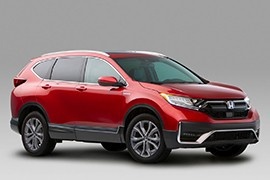
HONDA CR-V
Generations Timeline, Specs and Pictures

For over 20 years, the Honda CR-V has been the best-selling crossover in the United States, which is why Honda has decided to gift its fifth generation an extensive mid-cycle facelift for the 2020 model year.
Joining the Accord Hybrid and the Inside as the third electrified Honda produced on American soil, the CR-V Hybrid is also the first electrified Honda SUV in its U.S. lineup. Of course, a new hybrid version isn’t the only news surrounding the facelifted model.
Alongside the new two-motor hybrid electric version there is also a 1.5-liter turbocharged four-cylinder with VTEC technology available on all trim levels. The front and rear styling have received major upgrades as well, while the Honda Sensing active safety system has been made standard on all versions. On the front, the large openings for the fog lights are now integrated in the bumper, while the chrome grille is even more pronounced, making for a more aggressive look. The rear now features new dark-tinted taillights and a new dark chrome treatment for the garnish below the rear glass, while the bumper has been redesigned as well.

After years of leading the SUV market in the U.S., Honda CR-V returned in 2016 with a new generation. The new, bold and sophisticated styling features a frontal fascia dominated by two headlights that looked like some samurai eyes. Its overall design was bold and sophisticated and started debates. It was a love-it or hate-it design.
Inside, there was plenty of room for everybody. The flat-floor in the rear made the access easier and offered better comfort even when three adults were seated. Inside, the dashboard was mounted into a lower position, with a very easy to read instrument cluster. The infotainment unit didn’t match those which were already installed on the Civic from the same era since they couldn’t be paired with Android Auto and Apple CarPlay.
Depending on the market, the 2018 CR-V had five engine options and few gearboxes available. It was the first CR-V to boast a gasoline turbocharged engine, on the 1.5-liter version. It also kept the older 2.4-liter and 2.0-liter but upgraded to the newest emission standards. The 1.6-liter turbodiesel engine was updated above the previous generation and a Hybrid version was added.
For the transmission, the CR-V was offered as a 2WD or 4WD. For the hybrid, it had a CVT only, but for the others had either a 6-speed manual or a 9-speed automatic.

A facelifted Honda CR-V has been introduced at the Paris Motor Show 2014, coming with changes that mostly target the front fascia of the entry-level SUV.
There you’ll get a solid-looking grille, redesigned halogen headlights that sweep more on the quarter panels, a new skid plate and slightly different foglight surroundings. LED daytime running lights are also available. More functionality is assured via a new configurable center console, new rear console heat/air vent ducts, available 7-inch touchscreen display audio, a 10-way power driver’s seat, Lane Watch, heated front seats, smart entry with push-start button and more.

The 2012 CR-V receives all-new sheetmetal, and the result is a more refined look that should give Honda fans some hope for the future.
The interior has also been greatly improved, with a more contemporary layout, quick-stow rear seats and gobs of storage, though the top of the instrument panel and door caps are still rendered in hard plastic.
Power comes from Honda’s faithful 2.4-liver i-VTEC four-cylinder, with 185 horsepower and 163 pound-feet of torque – thats five more horsepower and two additional lb-ft compared to the outgoing CR-V. The transmission continues to be Honda’s tried and true five-speed automatic, which is a bit of a disappointment given the competition’s flurry of next-generation gearboxes offering more ratios. Still, Honda promises very competitive fuel economy numbers of 31 miles per gallon on the highway and 23 mpg in the city for the front-wheel drive model. The all-wheel drive variant should deliver an estimated 22 mpg in the city and 30 mpg on the highway.

The CR-V was already a Honda’s best seller and 2010 came with a new design that was supposed to attract even more buyers.
The CR-V nameplate was on the market from 1997 when the first generation was released. “CR-V” stood for “comfortable runabout vehicle” . And exactly how the name describes it, the crossover was designed for families in need of comfort and lots of space.
The exterior design changes included a restyled front grille that worked nicely with the big headlamps, new front and rear bumpers and a restyled hood.
The CR-V came with 4 trim levels. The base version, the LX, was already equipped with some nice features such as cruise control, keyless entry, sliding and reclining rear seats, as well as an auxiliary audio jack.
The top of the range, the E-XL with added navigation offered a power driver seats, leather upholstery, heated from seats, a dual-zone climate control, bluetooth connectivity and a backup camera.
Coming with only one engine option, the CR-V was driver by 2.4 engine developing 180 hp. The power plant was mated to a 5-speed automatic transmission, the CR-V not offering the option to choose a manual gearbox. The new engine developed with 14 hp more than the older generation.
A front-wheel-drive system was standard, however, users could choose the AWD system.
The cargo area was generous and the rigid cargo cover was useful for stacking.
The CR-V had a good handling with a precise steering, however, wind noise was present at higher speeds.
The CR-V obtained excellent crash scores, thus it was a good choice safety-wise.

The CR-V was the Honda’s most practical SUV, and for 2007, the refined vehicle got larger and more powerful.
The SUV was redesigned to serve the needs of a larger audience. Practicality was increased, with the previous version’s side-hinged rear gated and exterior-mounted spare tired replaced with an overhead liftgate and also an under-floor space to increase storage space.
For the interior, Honda upgraded the quality of the materials used, as well as added an available navigation for the first time.
A single engine option was available, namely the 2.4-liter 4-cyilinder powerplant that developed 166 hp. The engine was mated with a 5-speed automatic tranmission.
The 2007 CR-V was available in three trim levels, the LX, the EX and the EX-L. The base model was pretty well equipped, with 17-inch wheels, air-conditioning, a folding center tray and full power accessories.
The EX added alloy wheels, a moonroof, a better audio system and a rear cargo shelf.
Moving to the top of the range, customers enjoyed a DVD-based navigation system with a rear-view camera, a PC card reader and a rear subwoofer.
All trim levels came with available front-wheel-drive or an all-wheel drive system.
Safety wise, the majority of the features were standard, including antilock disc brakes, stability control, brake assist, front-seat side airbags and full-length side curtain airbags, as well as a tire-pressure monitor.
As the rear-view camera was only available with the top of the range trim level, the lower trim levels came with available parking sensors.

Just three years after introducing the CR-V’s second generation, Honda unveiled a facelifted version, which kept on the market for another two years.
The Japanese carmaker shook the automotive world when it introduced the first CR-V at the 1996 Chicago Auto Show. Honda was mainly known for its compact Civic range and the mid-size sedan Accord, but not as an SUV maker. In 2001, it introduced the second generation, and the customers stormed the doors. In Europe, the main problem was the lack of a diesel engine. Honda didn’t like the oil-burners but made one for the facelifted version.
From the styling point of view, there were not too many changes to the car, but the headlamps were different and sported two headlamps for the low and the high-beam, respectively. Its front bumper featured a black lower grille and a plastic shield. Other carmakers adopted the same solution but painted it in silver and called it a shield. In the back, the 2004 CR-V featured the same flip-up glass and right-hinged rear door.
The roomy interior offered five actual seats, with three-point belts for everyone, which was not that common in those days. One chapter where the CR-V was excellent was the trunk size, which could get up to 2040 liters (72.0 cu-ft) of space with the split-folding bench lowered and 950 liters (33.5 cu-ft) with the seats up.
Under the hood, apart from the 2.0-liter and the 2.4-liter gasoline engines, the Europeans received a long-awaited diesel version that boosted the CR-V sales.

As the first generation released in 1997 was the best-selling compact on the US market, Honda made sure that the 2nd generation was better in all aspects.
More powerful, with more interior room and cutting-edge safety technology, increased comfort and practicality, the CR-V was updated in 2002.
The old engine that felt a bit underpowered with the previous model was replaced by a 2.4-liter 4-cylinder engine that produced 160 hp and 162 pound-feet of torque. Mated with the new unit was a 4-speed automatic or a 5-speed manual transmission.
The 4-speed automatic featured the Grade Logic Control system designed to downshift automatically and hold a lower gear while climbing. Besides the new system, the reworked gearbox was smoother and offered better fuel efficiency.
For 2002, the CR-V was based on Honda’s Global Compact Platform that was used on the Civic and the RSX. The new platform offered more torsional and bending rigidity, thus the ride quality was improved and the CR-V got even safer.
The roomy cabin offered excellent headroom and legroom for both front and rear passengers, better than the space offered by the competitors.
For 2002, the CR-V was available in three trim levels: 2-wheel-drive and 4-wheel drive LX and the four-wheel-drive EX. The 2-wheel-drive LX was available only with the 4-speed automatic transmission, while both 4-wheel-drive trims offered both manual or automatic transmission.
Standard equipment with the LX included air conditioning, power windows and power locks, rear-seats heater ducts and a CD player, while the upper trim level EX added an upgraded audio system, keyless remote, a power moonroof, antilock brakes and side airbags.
Federal government crash tested, the CR-V obtained the maximum 5 stars for both frontal and side impact tests.

Honda tried its luck and entered the SUV segment in the mid-’90s introducing the CR-V lineup, and it was a huge success for the Japanese carmaker.
When the carmaker introduced the new SUV in Japan, it had the unpleasant surprise to be considered a mid-size vehicle, leading to higher taxes. For the rest of the world, the car’s width didn’t matter that much. It was considered normal or narrow, depending on the countries. In the U.S. the CR-V was considered a compact-sized SUV. Its main advantages were the independent suspension in all corners, the big interior space, and the roomy interior.
From the outside, Honda’s designers couldn’t make a design too different than a regular station wagon. The headlights looked similar to those installed on the British-built Civic sixth generation but scaled-up. Its black plastic bumper was black to cope better with bushes, but soon Honda understood that it was a bad idea, and the car looked unfinished. It looked like a mix between a station wagon and a minivan, with higher ground clearance from its sides.
Inside, the carmaker improved as much as it could. For vehicles fitted with the automatic transmission, Honda made a free passage from side to side on the front area, with a flat floor. Thanks to the absence of an intrusive transmission tunnel, there was plenty of room for three passengers in the back. The carmaker designed the car to be used as a camping vehicle. With the front seats tilted back and the bench folded, the interior was transformed into a wide, almost flat bed. Moreover, the trunk’s floor was a picnic folding table.
For the first generation, Honda made the CR-V with only one engine option, which sent the power in all corners via either a five-speed manual or a four-speed automatic.























































